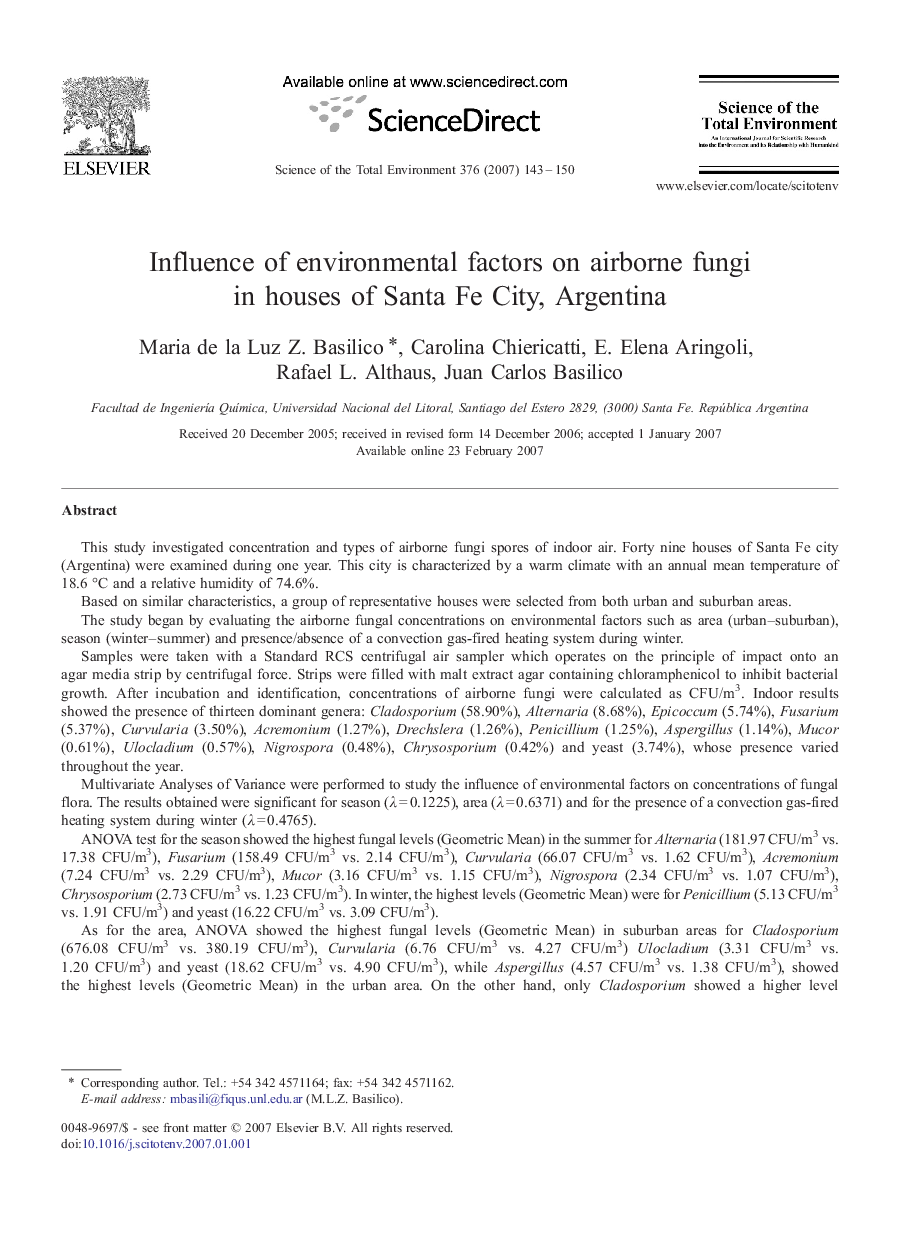| کد مقاله | کد نشریه | سال انتشار | مقاله انگلیسی | نسخه تمام متن |
|---|---|---|---|---|
| 4433484 | 1619955 | 2007 | 8 صفحه PDF | دانلود رایگان |

This study investigated concentration and types of airborne fungi spores of indoor air. Forty nine houses of Santa Fe city (Argentina) were examined during one year. This city is characterized by a warm climate with an annual mean temperature of 18.6 °C and a relative humidity of 74.6%.Based on similar characteristics, a group of representative houses were selected from both urban and suburban areas.The study began by evaluating the airborne fungal concentrations on environmental factors such as area (urban–suburban), season (winter–summer) and presence/absence of a convection gas-fired heating system during winter.Samples were taken with a Standard RCS centrifugal air sampler which operates on the principle of impact onto an agar media strip by centrifugal force. Strips were filled with malt extract agar containing chloramphenicol to inhibit bacterial growth. After incubation and identification, concentrations of airborne fungi were calculated as CFU/m3. Indoor results showed the presence of thirteen dominant genera: Cladosporium (58.90%), Alternaria (8.68%), Epicoccum (5.74%), Fusarium (5.37%), Curvularia (3.50%), Acremonium (1.27%), Drechslera (1.26%), Penicillium (1.25%), Aspergillus (1.14%), Mucor (0.61%), Ulocladium (0.57%), Nigrospora (0.48%), Chrysosporium (0.42%) and yeast (3.74%), whose presence varied throughout the year.Multivariate Analyses of Variance were performed to study the influence of environmental factors on concentrations of fungal flora. The results obtained were significant for season (λ = 0.1225), area (λ = 0.6371) and for the presence of a convection gas-fired heating system during winter (λ = 0.4765).ANOVA test for the season showed the highest fungal levels (Geometric Mean) in the summer for Alternaria (181.97 CFU/m3 vs. 17.38 CFU/m3), Fusarium (158.49 CFU/m3 vs. 2.14 CFU/m3), Curvularia (66.07 CFU/m3 vs. 1.62 CFU/m3), Acremonium (7.24 CFU/m3 vs. 2.29 CFU/m3), Mucor (3.16 CFU/m3 vs. 1.15 CFU/m3), Nigrospora (2.34 CFU/m3 vs. 1.07 CFU/m3), Chrysosporium (2.73 CFU/m3 vs. 1.23 CFU/m3). In winter, the highest levels (Geometric Mean) were for Penicillium (5.13 CFU/m3 vs. 1.91 CFU/m3) and yeast (16.22 CFU/m3 vs. 3.09 CFU/m3).As for the area, ANOVA showed the highest fungal levels (Geometric Mean) in suburban areas for Cladosporium (676.08 CFU/m3 vs. 380.19 CFU/m3), Curvularia (6.76 CFU/m3 vs. 4.27 CFU/m3) Ulocladium (3.31 CFU/m3 vs. 1.20 CFU/m3) and yeast (18.62 CFU/m3 vs. 4.90 CFU/m3), while Aspergillus (4.57 CFU/m3 vs. 1.38 CFU/m3), showed the highest levels (Geometric Mean) in the urban area. On the other hand, only Cladosporium showed a higher level (Geometric Mean) in houses without convection gas-fired heating system during winter, compared to that corresponding to heated houses.
Journal: Science of The Total Environment - Volume 376, Issues 1–3, 15 April 2007, Pages 143–150